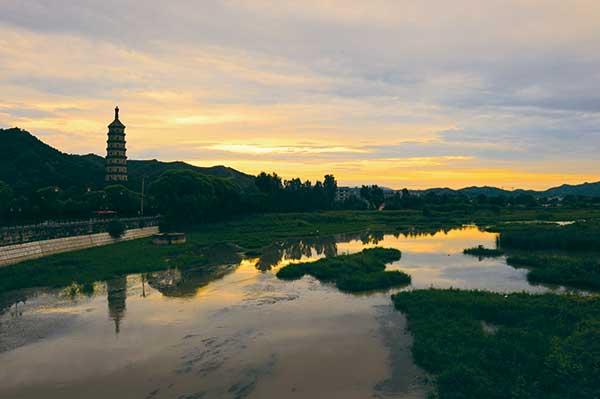hendge is a small, unassuming city in a mountain valley 180km northeast of Beijing in Hebei Province, that has a couple of killer features: a heap of palaces and temples to match, literally, the best in the country, plus the most standard Mandarin of anywhere in China. I decided, therefore, that the most fitting way to experience the town was on a language immersion homestay. This particular setup would be particularly immersive, I was about to learn.
Chengde’s two peculiarities both stem from the city being reasonably close to the capital. The parks and palace complexes were built as an escape from the summer heat of Beijing, and the dialect of surrounding counties was used by the new Communist government as the basis for what would become Standard Mandarin as it was close enough to Beijing phonology, but clearer and less politically controversial than enforcing the capital’s dialect on a nation.
My first introduction to the town was to be via my homestay. Coming by train from Beijing, you arrive into Chengde’s new town, and you could be forgiven for thinking you’re in any of thousands of similar-looking areas across the country. My host mother picked me up and took me to the family apartment, also in the new town that straddles the Wulie River.
But even before meeting her, I’d had to switch my phone into Chinese, and even my laptop operating system, because this was about total immersion. The school, Live The Language, in Beijing, had also asked me to tell all my friends that I would only be able to communicate in Chinese and that family back in the UK would have to go ignored. I was thrilled.
After meeting the family, including four-year-old granddaughter who would be one of my most committed tutors, we went out for a local specialty: leg of lamb. It was the local drinking culture that was more of a speciality and took me back to trips to China 15 years earlier. Because in Chengde, you can only drink in unison. Every slurp is a toast. This means no sipping when it suits, but also that whenever someone is ready for a toast, you have to go with it.
The next morning I met my teacher, who was also a tour guide as I’d opted for a mix of classes that would be indoors with a textbook and outdoors with a map. And on the spot quizzes, it would turn out.
We went straight to the heart of historic Chengde: the Mountain Resort. Known in Chinese as the “mountain villa for avoiding the summer heat,” it’s actually a series of temples, pavilions and lakes. Yet what makes it so appealing is that all these are set in landscaped parkland, more akin to the estate of an English stately home with its woods and meadows than a typical Chinese garden. It turned out to be such a success that it influenced the development of landscaping in Europe in the 18th century.
While there’s almost six square kilometers of UNESCO-certified beauty to roam in, my teacher and I sporadically had to leap out of the way of the high-speed open-sided carts ferrying the more time-pressed tourists from site to site, as we try to stroll through the pastures. She points out how the different architectural styles from across the country have all been brought together.
In a nutshell, the Qing emperor Kangxi developed a fantasy Manchu homeland for himself, handy for hunting and keeping cool, which developed into a diplomatic Disneyland. The resort was built between 1703 and 1792 and became the biggest palace and garden complex in China. It was very much for show, as the buildings, landscapes and outlying temples were designed to resemble or even replicate examples of existing places and architecture across China, creating a pastiche of the entire country.
With a big enough plot and budget, it escaped being a forerunner to theme parks and was a useful tool for winning favor with the people’s of the corresponding styles. The emperors would receive leaders of the different ethnic groups here in the summer.
Wherever the emperor went was the seat of government, so whenever he was summering in Chengde, the town was effectively the capital, which helped maintain a realm of authority northwards over the Mongol tribes.
The meadows are Mongolian grasslands, the pavilions could be straight from Jiangsu, yet perhaps the most direct copying is the Putuo Zongcheng Temple, aka the mini Potala, which I visited another day as a homework assignment.
Built to make the visiting Panchen Lama feel more at home, the vast temple structure is the spitting image on the outside of the original built a century earlier in Lhasa, though has a significant Han twist on the inside and the odd cement shortcut here and there.
Having a whole week in Chengde I was able to get around the resort and the outlaying temples during the day, then in the evenings tell my host family what I’d seen.
The wheeler-dealer father would take me on business lunches, the back of his car filled with gifts that would be traded for favors around town. The extended family lived in the same apartment block, calling round to give me more chances to practice speaking to people who, for once, actually speak with the clarity of people in textbook recordings. I could have done without the college-aged son coming into my room at 4am, cigarette in mouth, to see if I wanted to join him for “early exercises,” but it was at least another authentic experience.
By the time I got back to Beijing and spoke English again for the first time, I found my throat had somehow adapted to speaking Chengde Chinese and I was left coughing and spluttering in front of my puzzled friends.

 Old Version
Old Version


